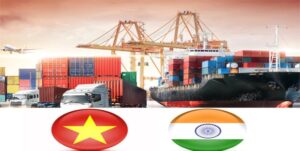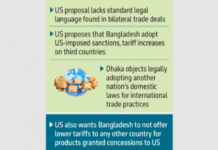Even though Vietnam is reckoned as having an edge over India in the global supply chain, India’s demographic advantages override Vietnam, writes S. Majumder for South Asia Monitor
New supply chain dynamics post-Covid: Advantage India or Vietnam?
The Covid-19 pandemic led to a colossal shift in manufacturing and supply chain globally. Hitherto, the global supply chain owed to low-cost manufacturing. China was in hegemony, sharing more than one-third of the global supply chain. Post-pandemic, supply chains are leaving the low-cost benefit at the backbench. MNCs are looking to relocate supply chain from low-cost benefits to low-risk destinations. Eventually, MNCs are considering shifting their plants and businesses from China. The most targeted destinations are Vietnam and India, according to the Quality Control & Supply Chain Audit (QIMA) report.
In other words, the pandemic was a wake-up call for MNCs to relocate their factories, largely dependent on China due to low cost-benefit, and shift to low-risk nations like Vietnam and India. Even though data revealed foreign investment increased in China post-pandemic, the rate of increase is under a downswing spiral. The slow rebound in sourcing from China signals a long-term diversification of supply chain sourcing.
According to a recent Q2 Barometer report by QIMA, Vietnam and India emerged as alternative sourcing locations. It revealed that roughly a third of global buyers and 38 percent of US buyers named Vietnam among the top three buying destinations as of early of 2021. An influx of US-based buyers increased inspection and audits from India. However, challenges are persisting in India.
India’s prospects
An AT Kearney survey report on supply chain, jointly made with the Council of Supply Chain Management Professional, determined six major trends that will shape India’s supply potential by 2025. One of them, the potential for supply chain, is growing urbanization and rapid growth in infrastructure. The second major trend is the government’s drive to encourage manufacturing such as extending Production Linked Incentive (PLI) scheme and massive fiscal support to MSMEs.
India decided to transform its manufacturing following the new trajectory of growth in the world. The Economic Survey 2019-20 underscored the necessity for transformation in manufacturing. It advocated the country to be a global hub for assembly operation and value chain manufacturing. To this end, PLI and MSMEs have become key role players.
India has the advantage of becoming a potential platform for value chain manufacturing. It owes cheap and abundant labour. This was advocated by Professor Arvind Panagariah: “India is abundant in labour and assembly of products. It must specialize in these activities across a large number of products.”
PLI benefits India?
PLI scheme is a major attempt to rejuvenate Make in India. It is an attempt to make India an integral part of the supply chain, according to the Economic Survey 2020-21. Hitherto, the scheme covered three sectors. Now, it has been extended to 10 more, embracing almost all manufacturing sectors required for the supply chain.
The success of PLI scheme is evidently visible. The electronic industry made a rapid growth during three-four years. Production of electronic goods reached Rs. 4,97,484 crore in 2020-21 from Rs. 4,58,006 crore in 2018-19. India’s share in global electronic manufacturing increased to 3.6 percent in 2019 from 1.3 percent in 2012.
The noteworthy growth was in mobile phone production. Production of mobile phones increased more than double (137 percent) between 2016-17 and 2019-20. India is the second-largest producer of mobile phones in the world. Incidentally, and rather paradoxically, the growth in mobile manufacturing was triggered by Chinese manufacturers. The Chinese made their debut, with Prime Minister Narendra Modi laying the red carpet to encourage FDI irrespective of political differences. The main attraction for Chinese investment was the demographic advantage of India and the rising protectionism through high tariffs. Against these backdrops, green shoots were visible for the success of PLI, claimed by the government.
Vietnam challenge
Vietnam has emerged as a new challenge in the global supply chain and, according to trade analysts, it edges out India. With its major policy reform “Doi Moi”, Vietnam removed self-imposed barriers and encouraged investment from FDI. It lowered the corporate tax to 22 percent in 2015 and further eased at 20 percent in 2016. It introduced a unique scheme for tax breaks. If a manufacturing operation fulfills minimum revenue or hires 3,000 workers or more in four years, the company becomes eligible for tax breaks.
FTA leverages Vietnam’s potential for supply chain exports. In 2020, major electronic items such as telephone sets, integrated circuits and transmission apparatus accounted for over 27 percent of total exports of Vietnam. FTAs, which played a key role in exports of Vietnam’s supply chain of electronic items, were AFTA (ASEAN Free Trade Area) and ASEAN–China FTA. Eventually, Vietnam became the second-biggest source for import of electronic items for India after China.
Given the dynamic changes in the global supply chain, FTAs should be given the right thrust in India’s new five-year Foreign Trade Policy which is likely to take effect from April 2022. FTA is the potential to expand the scope for export of supply chain manufacturing across the borders under competitiveness. So far FTA has been a bittersweet experience in India. It has been alleged that most of the FTAs were beneficial for partner countries. FTA will leverage the benefit for technology transfer through the import of components and materials at low cost.
Even though Vietnam is reckoned as having an edge over India in the global supply chain, according to QIMA, India’s demographic advantages override Vietnam in terms of domestic demand. It insulates the investors from the unprecedented global shock. India’s bounce back in GDP and fast growth in digitization will have a plural impact on the domestic supply chain.
(The writer is former Adviser, Japan External Trade Organization, New Delhi. The views expressed are personal.)
Read more at: https://www.southasiamonitor.org/spotlight/new-supply-chain-dynamics-post-covid-advantage-india-or-vietnam










